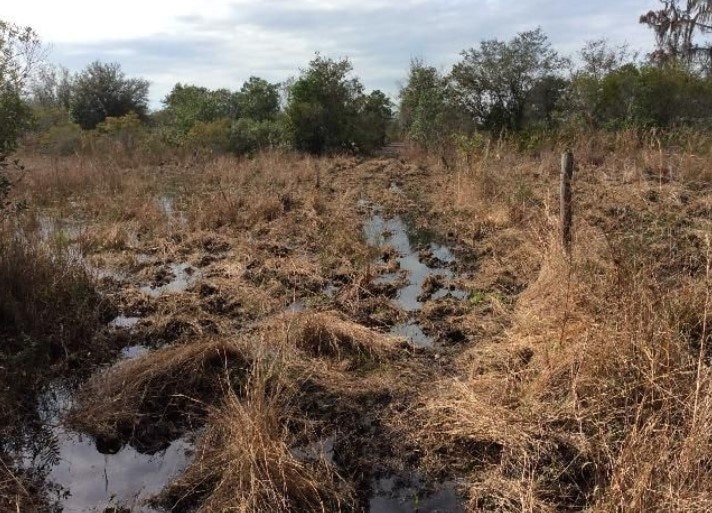Wildlife of Florida Factsheet: Feral Swine
By: Raoul K. Boughton, Bethany Wight, E. Hance Ellington, and Martin Main
An Ecological and Agricultural Invader
- Breeding = spring, summer, fall, winter
- Habitat = grassland, oak hammock, wetland, flatwoods, scrub
- Status = invasive

Credit: Reed Bowman
Scientific name: Sus scrofa
Common names: feral swine, wild hog, wild boar, razorback, piney woods rooter
Habitat: All habitats with a water resource, especially agricultural areas and wetlands.
Physical description: Black, brown, or brindled. Juveniles may be striped. Average body length 5–6 ft.
Weight: 75–250 lbs.
Reproductive rate: Populations increase rapidly because of their short gestation period (115 days), large litter sizes (6–8 piglets), and the ability of the sows to produce 1-2 litters/year each.

Credit: Sandy Burford
Lifespan: Average of 1–2 years, known to live up to 9–10 years in the wild.
Dispersal & home range: Female and young stay together in groups called sounders. Mature males disperse, sometimes >100 miles. Female dispersal activities are unknown. From a recent study on Florida cattle ranches, home range size of females was 370 acres and males 741 acres. Home range sizes can be smaller (100 acres) or larger (4,200 acres) depending on available resources, and feral swine are known to travel farther for supplemental food as natural resources decrease.
History: Feral swine are not native to the Americas and were introduced by Spanish settlers in the 1500s. In Florida, domesticated swine are thought to have been first introduced by explorers Juan Ponce de Leon in 1521 and Lucas Vazquez de Allyon in 1526, however, both expeditions failed and the fate of their pigs is unknown. In 1539, Hernando de Soto is credited with introducing and establishing pigs on the mainland, beginning near Tampa and traveling through 14 states. Later settlers and farmers used open range livestock practices, promoting the spread of swine. Feral swine are descendants of escaped/released domestic swine, hybrids of Eurasian wild boar and domestic swine, or wild boar in non-native habitat.

Distribution: Previously presumed to be limited to the south by harsh winters, feral swine are now estimated to be breeding in 39 states. They have been spotted as far north as Michigan, North Dakota, and Canada. The largest populations are found in warm states such as Texas, California, Florida, and Hawaii. Population estimates in Florida are >500,000, which could be a great underestimate. Populations continue to expand and increase in numbers without proper management.

Impacts: The most common type of damage by feral swine is from rooting. When swine root, they burrow into the soil with their snouts to find roots, tubers, fungus, etc. This rooting loosens the soil, destroys native vegetation, and modifies the chemistry and nutrients of the soil. Feral swine can greatly disrupt natural ecosystems, agricultural areas, livestock pastures, and residential areas. Feral swine also carry many diseases, some of which are transmittable to wild and domestic animals as well as humans. It is estimated that loss of agricultural products due to feral swine is >$2 billion/year in the United States.
Signs of Feral Swine

Credit: UF/IFAS

Credit: UF/IFAS

Credit: UF/IFAS

Credit: UF/IFAS

Credit: UF/IFAS

Fast Facts
- Forage by rooting, which can harm ecosystems
- No sweat glands; require water and shade to cool in hot environments
- One of the highest reproductive rates of mammals in North America
- Typically found in groups called sounders; males may be solitary
How You Can Help
- Do not relocate or transport feral swine
- Control feral swine on your property
- Collaborate with neighbors to control large areas
- Work with your local wildlife agency regarding recommended control efforts
More information and factsheets at https://edis.ifas.ufl.edu
